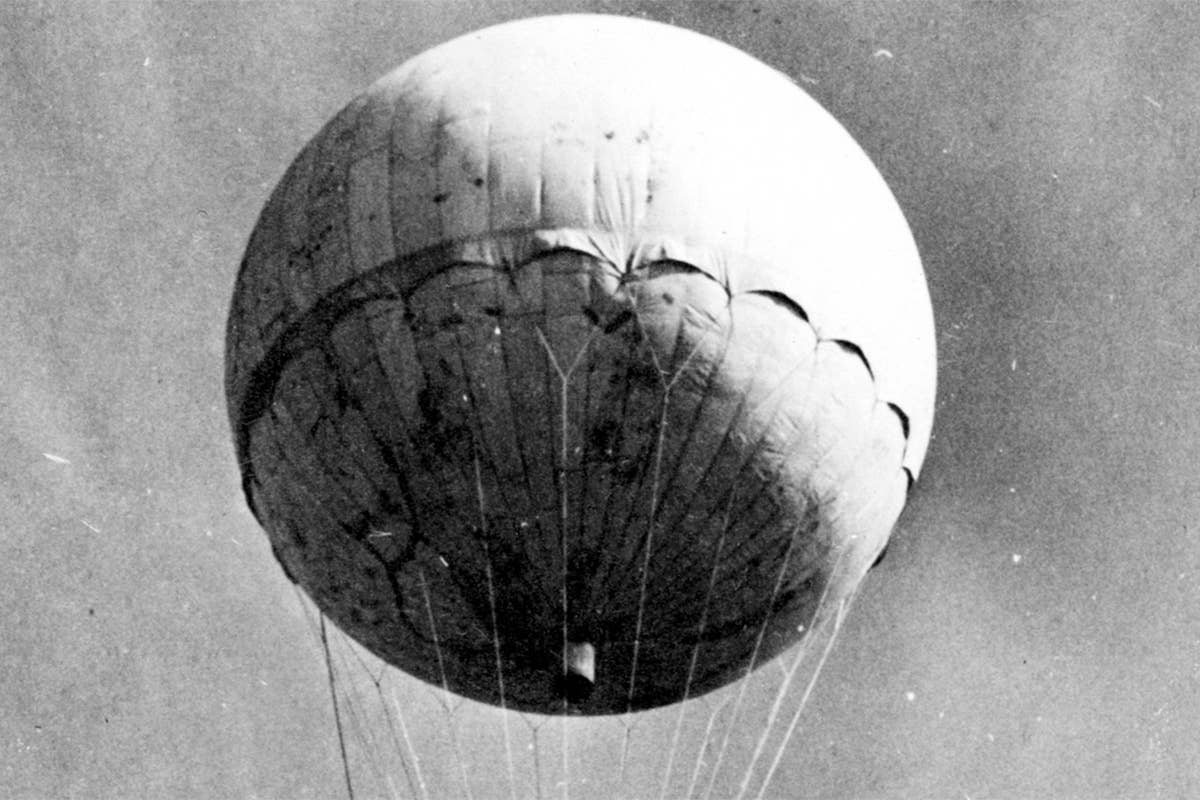When Six Americans Were Killed By a ‘Balloon Bomb’
A balloon used for warfare by the Japanese resulted in the only Americans to die on U.S. soil from enemy action in during World War II.

In 1944, the Japanese military tried to instill panic in the U.S. by launching thousands of bombs carried across the Pacific by means of hydrogen-filled balloons. [Courtesy: National Museum of the U.S. Air Force]
May 5, 2022, marks the 77th anniversary of the deaths of six Americans, the only Americans to die on U.S. soil from enemy action in World War II. They were killed by a Japanese Fu-Go, also known as a balloon bomb.
Fear, Panic and Forest Fires
In 1944, the Japanese military tried to instill panic in the U.S. by launching thousands of bombs carried across the Pacific by means of hydrogen-filled balloons. The bombs were designed primarily as incendiary devices. The target was the forests of the Pacific Northwest. Because they were made of paper, it was believed the balloon bombs would explode and burn, leaving no trace. According to Japanese documentation, it was thought the fires would pull resources away from the military and the stealthy nature of the balloon bombs would unnerve and terrify the populace.
Balloon Bomb Construction
The Fu-Go balloons measured 70 feet by 33 feet and were made primarily of paper. Inflated with hydrogen, they were designed to fly at 30,000 feet where the prevailing winds carried them east toward the U.S. It took three to four days for a balloon to cross the Pacific. The balloons carried sandbags designed to release when a pressure sensor determined the balloon had descended below 30,000 feet. The balloons would rise when the hydrogen was heated by the sun and lower again when the hydrogen cooled at night. When all of the sandbags were dropped, the balloon was supposed to self-destruct. Each balloon carried a total of three bombs suspended by tethers from the shroud: one was a 33-pound, high-explosive anti-personnel device and the other two were designed to start fires.
According to OregonEncyclopedia.org, between November 1944 and April 1945, Japan launched approximately 9,300 Fu-Go balloons. An estimated 900 balloons reached the U.S.
Most of the balloons came down in remote areas; the forest fires created by some of the balloons were quickly extinguished by the rain for which the Pacific Northwest is so famous.
There are reports of the balloons being sighted in:
- Wyoming
- The Aleutian Islands
- Canada
- California
- Michigan
- Oregon
Some of the balloons crashed and exploded and burned but did not injure anyone. Americans became wise to the origin of the balloon bombs when some of them crashed and did not explode with the sandbags still attached. A study of the sand revealed it was from the Pacific rim—it was black sand with microscopic amounts of seashell in it, leading the Americans to deduce the devices have come from Japan.
Hoping to prevent a panic—and more importantly to keep the Japanese from learning the bombs had reached America—the U.S. Office of censorship requested the media keep quiet about the balloon bombs. The media complied.
Casualties in Oregon
On May 5, 1945, one of the balloons was found by Sunday school children in south central Oregon.
Minister Archie Mitchell, his pregnant wife, Elsie, and children from Mitchell's Sunday school class were on an outing in the woods. Mitchell told local media that he was retrieving lunch from the car when the others called to him, saying they had found what looked like a large balloon. Mitchell shouted a warning, but it was too late. The bomb exploded, killing his 26-year-old wife; Dick Patzke, 14; Jay Gifford, 13; Edward Engen, 13; Joan Patzke, 13; and Sherman Shoemaker, 11.
A story about the explosion and loss of life appeared in the Klamath Falls Herald and News, but it did not provide details about the explosion, except to say it was of unknown origin. There was no mention of a Japanese balloon bomb. The details would not come out until after the war.
Today, there is a monument to the victims located in the Fremont-Winema National Forest northeast of the city of Bly, Oregon. Known as the Mitchell Monument Historic Site, the stone monument was established in 1950. It features a bronze plaque listing the names of the victims and marks the only place in the continental U.S. where persons were killed by enemy action during World War II.
In 2003, the monument was placed on the National Register of Historic Places.

Subscribe to Our Newsletter
Get the latest FLYING stories delivered directly to your inbox






